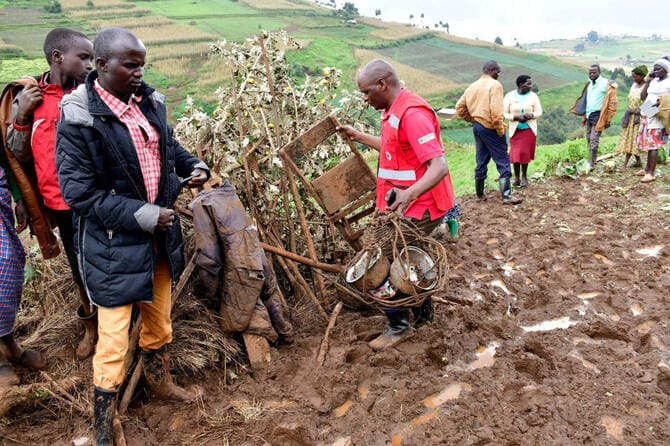We're loading the full news article for you. This includes the article content, images, author information, and related articles.
Following a deadly landslide in Elgeyo Marakwet, experts and officials are calling for a fundamental shift from reactive crisis response to a robust, long-term strategy of prevention and preparedness to mitigate the escalating human and economic costs of these disasters.

A devastating landslide struck villages in Marakwet East, Elgeyo Marakwet County, on Friday, November 1, 2025, following days of intense rainfall. As of Sunday, November 2, 2025, government officials confirmed the death toll had risen to 26, with 25 people still missing. The tragedy, which buried homes and displaced over 1,000 households, has once again highlighted Kenya's profound vulnerability to landslides, particularly in the western Rift Valley and highland regions. A multi-agency response involving the Kenya Defence Forces, National Police Service, and Kenya Red Cross was swiftly mobilized, with helicopters airlifting at least 26 injured survivors to Moi Teaching and Referral Hospital in Eldoret for treatment. Government spokesperson Isaac Mwaura and Interior Cabinet Secretary Kipchumba Murkomen have assured the public of the government's full support, including covering medical and funeral expenses for the victims.
This latest disaster did not occur without warning. In late October 2025, the Kenya Meteorological Department (KMD) issued several heavy rainfall advisories for the October-November-December short rains season. KMD specifically warned of rainfall intensifying to over 30mm in 24 hours across dozens of counties, including Elgeyo Marakwet, and cautioned residents in landslide-prone areas to remain on high alert. The alerts were disseminated to key government bodies, including the National Disaster Operations Centre (NDOC).
Experts point to a confluence of factors exacerbating the landslide risk. The region's steep topography, combined with porous volcanic soils, makes it inherently unstable. This natural vulnerability is dangerously amplified by human activities. Widespread deforestation for agriculture, settlement, and charcoal production has stripped slopes of the vegetation that helps stabilize the soil. According to the 2017 National Disaster Risk Management Policy, Kenya has been losing over 5,700 hectares of forest annually since 1990. Unsustainable farming practices on steep inclines further contribute to soil degradation, making the land more susceptible to collapse when saturated by heavy rains.
Elgeyo Marakwet and neighboring counties like West Pokot have a tragic history of fatal landslides. In November 2019, a landslide in West Pokot killed at least 52 people and displaced thousands. Another incident in April 2020 along the border of the two counties resulted in 29 deaths and displaced 4,000 people. These recurrent events underscore a persistent pattern of disaster in the region. The economic toll is substantial, with landslides estimated to cost Kenya between 2% and 2.4% of its GDP annually, as noted by National Treasury Principal Secretary Chris Kiptoo during a visit to the affected site.
In the wake of the Marakwet East tragedy, there is a growing consensus on the urgent need for a strategic shift from crisis management to proactive risk reduction. While the immediate response has been coordinated, officials and experts stress that long-term solutions are critical. Recommendations include enforcing sustainable land-use planning, implementing widespread afforestation and environmental restoration in high-risk zones, and investing in robust early warning systems that are effectively integrated with community preparedness and evacuation plans.
The Elgeyo Marakwet county government has previously mapped high-risk zones but faced challenges in resettling vulnerable populations. This highlights the complex socio-economic factors that compel communities to live in hazardous areas. In response to the nation's broader challenges, the Kenyan government launched the National Disaster Risk Management Strategy (2025–2030) in June 2025, aiming to create a more coordinated and proactive framework. Additionally, the 'Early Warnings for All' initiative, launched in May 2025, seeks to ensure every citizen is protected by early warning systems by 2027. The Ministry of Health has also initiated psychosocial support programs for the affected families, recognizing the deep trauma inflicted by such disasters.
As search and rescue operations continue, the tragedy in Elgeyo Marakwet serves as a stark reminder of the pressing need to translate these national strategies into concrete, localized action. Experts argue that sustained investment in prevention, community education, and environmental restoration is not merely a policy option but a critical necessity to break the deadly cycle of landslides and safeguard Kenyan lives and livelihoods.
Keep the conversation in one place—threads here stay linked to the story and in the forums.
Other hot threads
E-sports and Gaming Community in Kenya
Active 7 months ago
Popular Recreational Activities Across Counties
Active 7 months ago
The Role of Technology in Modern Agriculture (AgriTech)
Active 7 months ago
Investing in Youth Sports Development Programs
Active 7 months ago